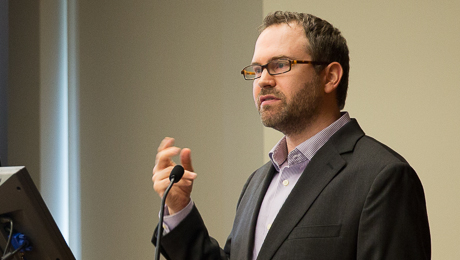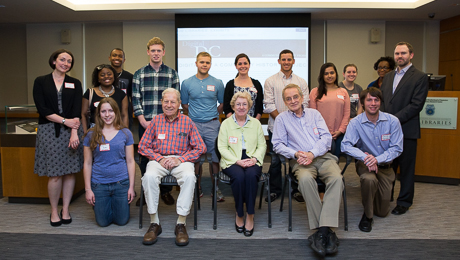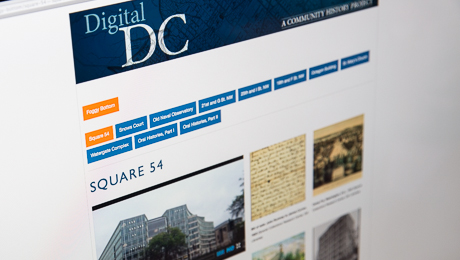Although Chioma Aneke has spent her entire life in Washington, DigitalDC has got her looking at the city in a whole new way. The interactive project required her to conduct in-depth research analyzing Washington through the decades, leading Ms. Aneke to discover the layers of history behind her home.
“Each building in D.C. has a lot more meaning to me now,” she said. “Every street has its own presence.”
DigitalDC was the central assignment in Associate Professor of History Christopher Klemek’s class “Washington, D.C.: History, Culture, Politics” this past semester. His students examined primary documents and other resources to chronicle D.C. history for an interactive online exhibition supported by the Columbian College of Arts and Sciences, the Center for Civic Engagement and Public Service, the Gelman Library’s Special Collections Research Center and the University Writing Program, along with the Historical Society of Washington, D.C., and D.C. Public Libraries.
The class was split into groups that focused on nine different areas in Foggy Bottom, including Snow’s Court, 19th Street, the Old Naval Observatory on 23rd Street and the block on the Southeast edge of Washington Circle known as Square 54. They pored through materials in the Gelman Special Collections Research Center, and then ventured into the city to do research in places like the Library of Congress and the National Archives. All their work culminated last week when the class held a presentation to debut their findings on DigitalDC to GW and the surrounding community. The online exhibtion is publicly accesible through the GW Libraries website.
“It’s very gratifying to see something like this come to fruition because it’s a distinctive, unique project that reflects the best utilization of the resources that are available at GW and the D.C. community more broadly,” Dr. Klemek said.

Professor Christopher Klemek speaks at Monday's presentation of DigitalDC.
Nearly half of the class was composed of high school students from the School Without Walls participating in GW’s Early College Program. Students like Ms. Aneke complete classes at GW and experience the rigors of college life while earning both their high school diploma and an associate’s degree from the university. As part of the program, they must take a class on D.C. history—a requirement Dr. Klemek’s course satisfied.
“Dr. Klemek’s focus on using primary documents for research is something every college student has to learn,” said Dan Ullman, the associate dean for undergraduate studies at CCAS. “He taught them not only how to read these kinds of documents, but really how to do history.”
Special Collections Public Services and Outreach Librarian Jennifer Kinniff helped guide students through the process of amassing resources and information. The students would submit their findings to Dr. Klemek through a series of papers. The professor worked with exhibit developers and Ms. Kinniff to integrate the student research onto the DigitalDC website, which now includes text, videos, images, maps and photographs from the Foggy Bottom sites from archives around Washington.
Greg Hall, B.A. ’14, focused on the development of Square 54 from 1940 to 1970. He became acquainted with the construction and expansion of the site by visiting the D.C. Public Library's Special Collections Reading Room to examine plat maps and real estate atlases, which detail building structures and materials throughout the years. A close look at the maps showed him how the city was planned and urbanized and when D.C. dwellers began investing more money into their homes by using brick instead of wood.
Mr. Hall said he was primarily interested in the class because he wanted to learn more about the area surrounding campus before graduating.
“D.C. history is not something I’ve really looked into, but I thought it would be a cool opportunity considering I’ve spent four years of my life here,” he said.
Although all of the areas were in the heart of GW, rising sophomore Cole Love-Baker explained he was surprised that neither he nor his fellow students had heard much about certain places until taking the class. He was assigned to the Old Naval Observatory, once one of the most prominent scientific institutes in D.C. After reading articles and talking to experts, he found that he’d become very passionate about preserving the site and sharing its history with others.
In addition to primary documents, Dr. Klemek also asked students to conduct interviews with a D.C. resident who could provide anecdotes and narratives. While researching 19th Street, senior Sydney Noto and Patrick Kennedy, B.A. ’14, discovered that the place that Thurston Hall sits used to be a hotel for women. Later, it was acquired by GW and converted into an all-female residence hall. The pair interviewed Mary Phelan, B.A. ’68, one of the first hall residents. Ms. Phelan told them everything, from the feel of the neighborhood to how she had to obey the university’s curfew while living in the building.
“I can look at a newspaper directory and find articles to tell me about contemporary development, but what she gave us was an actual on-the-ground sense of what living in the neighborhood was like. It was much more vivid than what I could have gotten from any archival source,” Mr. Kennedy said.
Ms. Phelan and other interview subjects attended Monday’s presentation. Ms. Kinniff added that many attendees came from partner institutions that had helped students with the project, showing how collaborations between GW and other organizations can serve the public.

The class and interview subjects at the unveiling of DigitalDC. First row: Bryn Baffer, George Arnstein, Mary Phelan, Ray Rhinehart, Patrick Kennedy. Second Row: Jenny Kinniff, Jackie Alston, Ryan, Jones, Glen Forster, Nicholas Dinella, Hannah Fried-Tanzer, Ryan Xepoleas, Amara Chaudhry, Nicole Cunningham, Chioma Aneke, Professor Christopher Klemek.
“It really shows what we can accomplish when we work with institutions within D.C.,” she said.
Dr. Klemek said the presentation was an ideal way to celebrate the debut of DigitalDC and the hard work of students, who are contributing a learning experience to both GW and Washington.
“This project helps GW students understand and appreciate Washington as a classroom where they can learn about the past,” Dr. Klemek said. “And for the broader D.C. community, it's a way for GW to demonstrate the important contributions that we can make toward appreciating the city’s rich history.”


